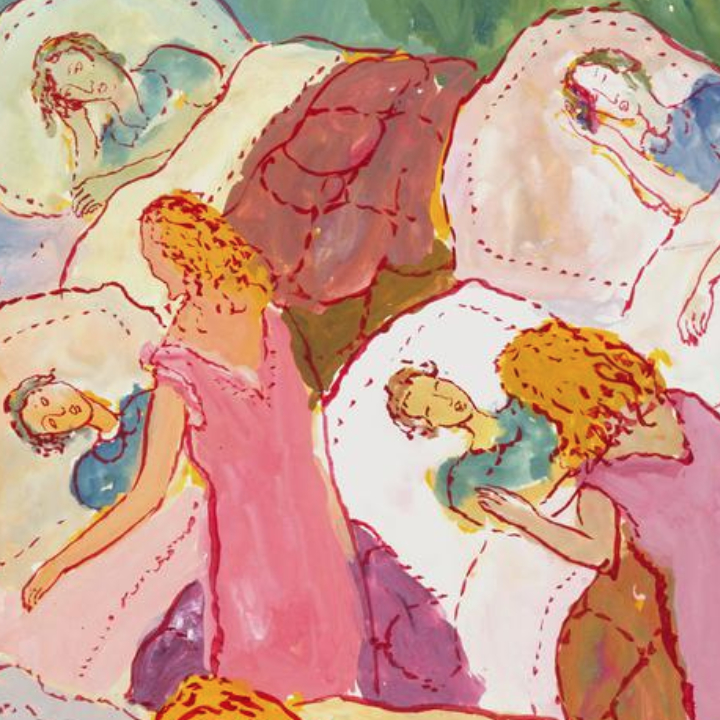Life? Or Theatre? By Charlotte Salomon – Pages M004237, M004245, and M004300
As I mentioned before, Life? or Theatre? tells the story of Charlotte Salomon’s family, keeping the given names but changing the surnames. So far, I took us through the first hundred pages which cover the lives of Salomon’s mother and father, Franziska and Albert. The focus in these pages is mainly on Franziska and we see her growing depression and eventual suicide. The story then shifts to Charlotte’s childhood and Paulinka, the singer who becomes Charlotte’s stepmother. The pages I wish to discuss concern the growing relationship between Charlotte and Paulinka.
M004237
At this point, Charlotte has returned to her father’s home after staying with her grandparents (presumably to allow the newlyweds to have time together). What we see in the succeeding pages are Charlotte’s feelings for Paulinka. Almost immediately, Charlotte becomes obsessed. Paulinka is a new friend, but also a surrogate mother. And perhaps more.

On page M004237 we see Charlotte watching her father and Paulinka. The text says that Charlotte is jealous of her father; she wants all of Paulinka’s attention. At the bottom of the page, we see them finally embracing while Paulinka lies in bed. The layout of this page echoes the earlier pages of Charlotte’s mother, Franziska who spent much of her time in bed before her suicide. Salomon would often repeat images of her bedridden mother on the same page, just as she depicts Paulinka on this page. So there is a visual echo to connect Paulinka with Franziska. But besides making it clear that Paulinka fills the role of a new mother, the echo is also unsettling. As I mentioned, Franziska was in bed due to her mental illness. So seeing Paulinka like this casts a spectre over the action.
Also, Charlotte’s obsession seems to go beyond a love of a daughter for her new mother. A few pages later, on M004248, the women are referred to as lovers and hearts adorn the top of the page. It’s difficult to tell what the nature of this “love” is. Does Charlotte have romantic feelings for Paulinka? Is this the story of a young lesbian discovering her sexuality? And what about Paulinka? She has been alone and pursued by various men, so she obviously enjoys Charlotte’s attention. Yet she doesn’t seem to see Charlotte as anything other than a young girl whom she now is responsible for. Paulinka finds Charlotte’s jealous behavior distasteful and selfish. And yet she longs to be reunited with her “lover.”
So what Charlotte depicts in these pages is a vary layered and nuanced relationship between two women.
M004245
Salomon also depicts Paulinka’s protectiveness of her new husband and stepdaughter. Paulinka becomes convinced that all the problems in the family stem from Franziska’s parents whom she sees as wanting perfection and disallowing expressions of emotion. This leads Paulinka to write an accusing letter to Charlotte’s grandmother, Mrs. Knarre.

Before the letter, on page M004245, Salomon shows us Paulinka discussing her ideas with Albert. Salomon uses what we would now refer to as thought balloons. In these, Salomon places the images of Paulinka’s thoughts: Franziska beset by stabs of judgement, lonely and vulnerable Charlotte, and the window, which in the book is now firmly a symbol of suicide. Juxtaposed, the thought process is clear. The same conflicts that Franziska endured are now being inflicted on Charlotte, which Paulinka fears will lead the girl to commit suicide herself. We see Paulinka holding the thought of Charlotte and then turning away in tears. Whether or not Paulinka’s analysis is correct, Salomon clearly depicts Paulinka’s thought process and progress of emotion. And here the color red seems to symbolize the oppressive emotions that have haunted the family.
M004300
So Paulinka writes her conclusions in a letter and sends it off to her mother-in-law. At this point, Salomon decides to shift the focus of the book to her grandmother, Mrs. Knarre. This starts with Scene 5 and what we get is a retelling of many of the events we knew previously, but from Mrs. Knarre’s perspective. This adds additional layers to what we know and also creates reader sympathy for Mrs. Knarre. It would be easy to agree with Paulinka if Salomon did not give us these pages to explain her grandmother’s own suffering and feelings of helplessness.
The style of the book also shifts here. Up till now, many pages were composed of repeated images, such as the same character in bed. Now, most of the pages contain a single image, usually a character or group. So the juxtaposition does not happen on a single page as it used to, but between different pages. This shift in approach continues through the rest of the book. Yet some pages still do contain multiple “panels.”

One of the final pages we see in scene 5, page M004300, is of Mrs. Knarre before a window, head in her hand, feeling the full weight of the letter she has just read. By telling us Mrs. Knarre’s story, we understand how hurtful Paulinka’s letter is and so when we see her slouched on this page, we feel the weight of what is bearing down upon her.
Salomon also chooses to place Mrs. Knarre before a window. As I already mentioned, since Franziska’s death, the window has been used as a symbol of suicide and mental illness in the book. So placing Mrs. Knarre before one symbolizes what she is reflecting on and the guilt and sadness she must feel as a mother. It also hints at Mrs. Knarre’s own mental state and foreshadows her own death. The redness of the ground outside also echoes how the color has often been used to represent negative and oppressive emotions. So what Charlotte Salomon has done is develop her own visual syntax which she deploys to deepen the meaning of her pages.


